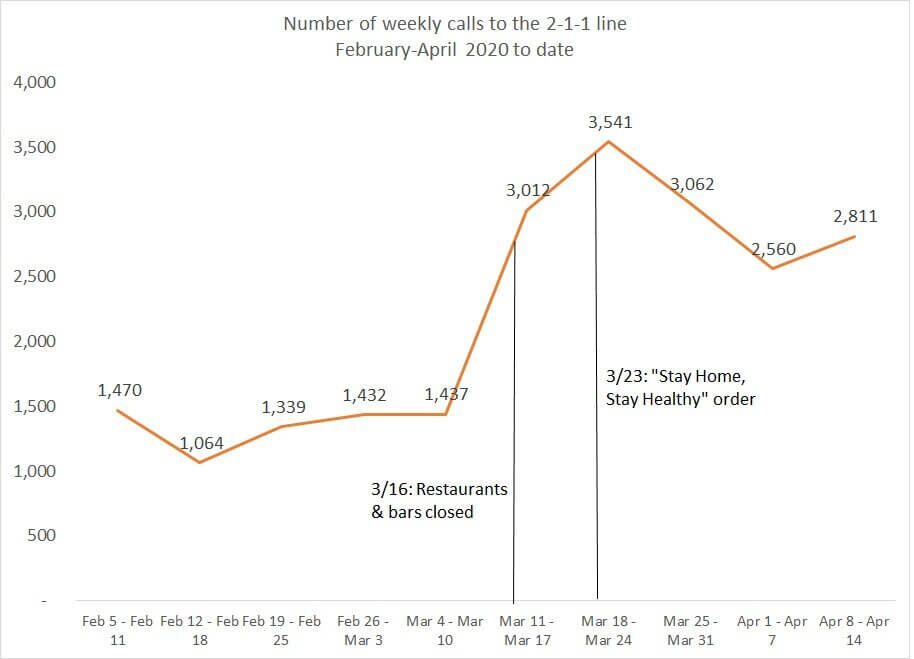Learning about basic needs during social distancing through 2-1-1
On March 23, Washington Governor Jay Inslee issued a “Stay Home – Stay Healthy” order to protect Washingtonians from the novel coronavirus, also known as COVID-19. The order requires every Washingtonian to stay home, except for people pursuing an essential activity, working at an essential business, or going outside for walks and exercise (as long as they keep 6 feet apart). This order followed on weeks of less stringent public health recommendations for social distancing to help slow the spread of COVID-19.
These changes are having far-reaching impacts in our communities. While essential workers continue their work, some people have switched to telecommuting, while others have been laid off, furloughed, or had their hours reduced. Students have switched to distance learning, and many parents whose children attended school or childcare must now care for them at home fulltime. So how is all of this impacting the ability of families to meet their basic needs?
While we don’t know the full answer to that question yet, we can find helpful clues in data from 2-1-1. King County’s Crisis Connections operates the 2-1-1 line, a service that provides referrals to King County residents with critical social service needs. Looking at the number of calls for various services can help us understand what needs residents are seeking assistance with during this time.
How many King County residents called 2-1-1?
Between February 5 and April 14, 2020, there were about 22,000 calls from King County residents to 2-1-1. In March, the volume of calls more than doubled in a matter of just two weeks. We can see that the overall number of calls increased greatly as social distancing began to take effect.
What kinds of support did callers need?
In February and March, “housing and shelter” and “disaster relief” were the most common needs for 2-1-1 callers. These do not include calls to the COVID-19 hotline. Each represented about 30% of calls overall during this two-month period. “Disaster relief” can include many needs related to a disaster such as food, shelter, transportation, health, and safety. The need for disaster relief was much higher in March than February. The week of March 18-March 24, over half of 211 calls were for disaster relief assistance.
New data system in effect April 1
A new data system was implemented which includes a revision of the categories above, making it challenging to compare with prior data. Looking at the calls in the first two weeks of April, housing remains the biggest need. Among the top 8 types of requests shown below, almost half of calls (46%) were for housing assistance. In the housing category, rent payment assistance was by far the most common need, representing almost half of housing-related needs. The second most common need was for food and meals, such as food banks and food stamp applications. In the disaster services category, unemployment assistance was the most common need.
Note: the time scale on the graph above showing requests for assistance in April is different than the graph showing requests in February and March. This shows only the most recent April data, rather than two months.
Overall, these data suggest that social service needs have increased due to the economic impacts of COVID-19, and that housing is a key area of need for King County residents.
For additional information and resources related to COVID-19:
Visit Communities Count’s COVID-19 Vulnerable Communities Data Tool for information on which communities in King County may be more impacted by COVID-19, due to age, health conditions, healthcare access, and social and economic conditions.
Visit King County’s COVID-19 Outbreak Data Dashboard for daily updates of a summary of COVID-19 test results, status of cases in King County by region, and breakdown of test results by sex at birth and age group.
Visit Public Health Seattle & King County’s COVID-19 website for recent updates, recommendations on protecting our community, fact sheets and translated materials.
Visit the King County Department of Community and Human Services’ COVID-19 website for links to Community and School resources including information on housing, behavioral health services, and free meal distribution sites for students.



